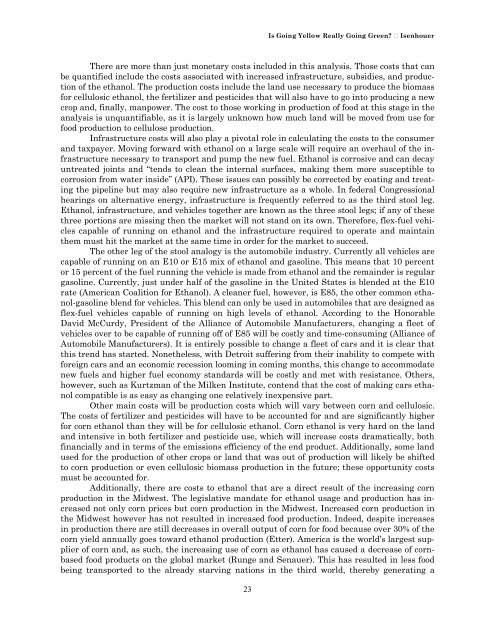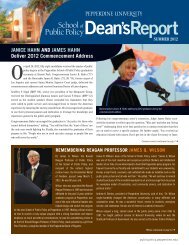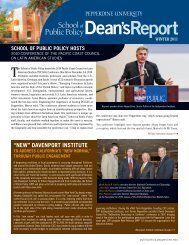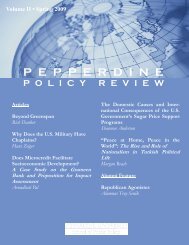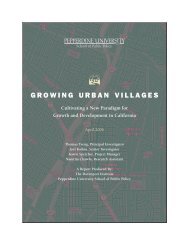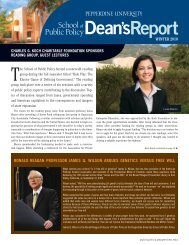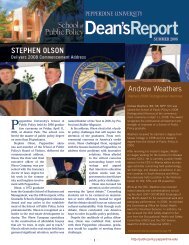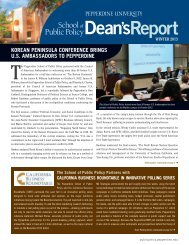Pepperdine University School of Public Policy
Pepperdine University School of Public Policy
Pepperdine University School of Public Policy
You also want an ePaper? Increase the reach of your titles
YUMPU automatically turns print PDFs into web optimized ePapers that Google loves.
Is Going Yellow Really Going Green? Isenhouer<br />
There are more than just monetary costs included in this analysis. Those costs that can<br />
be quantified include the costs associated with increased infrastructure, subsidies, and production<br />
<strong>of</strong> the ethanol. The production costs include the land use necessary to produce the biomass<br />
for cellulosic ethanol, the fertilizer and pesticides that will also have to go into producing a new<br />
crop and, finally, manpower. The cost to those working in production <strong>of</strong> food at this stage in the<br />
analysis is unquantifiable, as it is largely unknown how much land will be moved from use for<br />
food production to cellulose production.<br />
Infrastructure costs will also play a pivotal role in calculating the costs to the consumer<br />
and taxpayer. Moving forward with ethanol on a large scale will require an overhaul <strong>of</strong> the infrastructure<br />
necessary to transport and pump the new fuel. Ethanol is corrosive and can decay<br />
untreated joints and “tends to clean the internal surfaces, making them more susceptible to<br />
corrosion from water inside” (API). These issues can possibly be corrected by coating and treating<br />
the pipeline but may also require new infrastructure as a whole. In federal Congressional<br />
hearings on alternative energy, infrastructure is frequently referred to as the third stool leg.<br />
Ethanol, infrastructure, and vehicles together are known as the three stool legs; if any <strong>of</strong> these<br />
three portions are missing then the market will not stand on its own. Therefore, flex-fuel vehicles<br />
capable <strong>of</strong> running on ethanol and the infrastructure required to operate and maintain<br />
them must hit the market at the same time in order for the market to succeed.<br />
The other leg <strong>of</strong> the stool analogy is the automobile industry. Currently all vehicles are<br />
capable <strong>of</strong> running on an E10 or E15 mix <strong>of</strong> ethanol and gasoline. This means that 10 percent<br />
or 15 percent <strong>of</strong> the fuel running the vehicle is made from ethanol and the remainder is regular<br />
gasoline. Currently, just under half <strong>of</strong> the gasoline in the United States is blended at the E10<br />
rate (American Coalition for Ethanol). A cleaner fuel, however, is E85, the other common ethanol-gasoline<br />
blend for vehicles. This blend can only be used in automobiles that are designed as<br />
flex-fuel vehicles capable <strong>of</strong> running on high levels <strong>of</strong> ethanol. According to the Honorable<br />
David McCurdy, President <strong>of</strong> the Alliance <strong>of</strong> Automobile Manufacturers, changing a fleet <strong>of</strong><br />
vehicles over to be capable <strong>of</strong> running <strong>of</strong>f <strong>of</strong> E85 will be costly and time-consuming (Alliance <strong>of</strong><br />
Automobile Manufacturers). It is entirely possible to change a fleet <strong>of</strong> cars and it is clear that<br />
this trend has started. Nonetheless, with Detroit suffering from their inability to compete with<br />
foreign cars and an economic recession looming in coming months, this change to accommodate<br />
new fuels and higher fuel economy standards will be costly and met with resistance. Others,<br />
however, such as Kurtzman <strong>of</strong> the Milken Institute, contend that the cost <strong>of</strong> making cars ethanol<br />
compatible is as easy as changing one relatively inexpensive part.<br />
Other main costs will be production costs which will vary between corn and cellulosic.<br />
The costs <strong>of</strong> fertilizer and pesticides will have to be accounted for and are significantly higher<br />
for corn ethanol than they will be for cellulosic ethanol. Corn ethanol is very hard on the land<br />
and intensive in both fertilizer and pesticide use, which will increase costs dramatically, both<br />
financially and in terms <strong>of</strong> the emissions efficiency <strong>of</strong> the end product. Additionally, some land<br />
used for the production <strong>of</strong> other crops or land that was out <strong>of</strong> production will likely be shifted<br />
to corn production or even cellulosic biomass production in the future; these opportunity costs<br />
must be accounted for.<br />
Additionally, there are costs to ethanol that are a direct result <strong>of</strong> the increasing corn<br />
production in the Midwest. The legislative mandate for ethanol usage and production has increased<br />
not only corn prices but corn production in the Midwest. Increased corn production in<br />
the Midwest however has not resulted in increased food production. Indeed, despite increases<br />
in production there are still decreases in overall output <strong>of</strong> corn for food because over 30% <strong>of</strong> the<br />
corn yield annually goes toward ethanol production (Etter). America is the world’s largest supplier<br />
<strong>of</strong> corn and, as such, the increasing use <strong>of</strong> corn as ethanol has caused a decrease <strong>of</strong> cornbased<br />
food products on the global market (Runge and Senauer). This has resulted in less food<br />
being transported to the already starving nations in the third world, thereby generating a<br />
23


